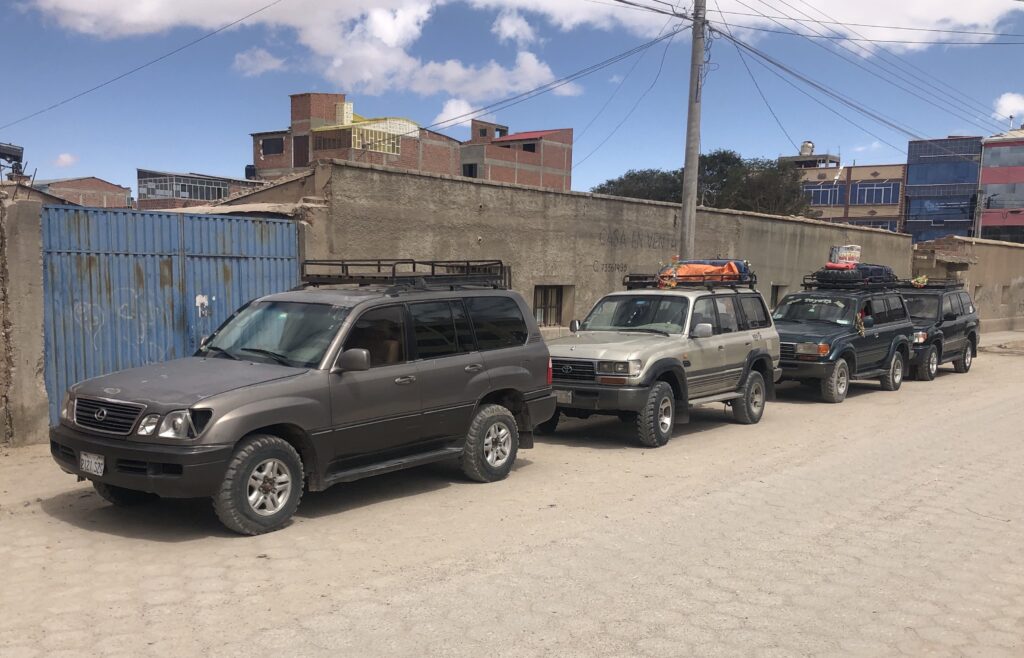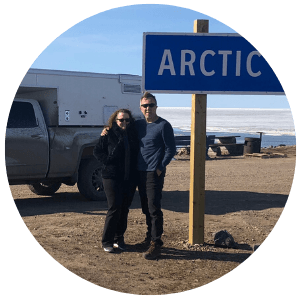From Rainbow Mountain it was only a few hours drive south to Puno and then on to Bolivia via scenic Lake Titicaca. Arriving in Puno with time to visit the Uros islands we hopped on a short “tour” of the Uros (floating ) islands. Home to an indigenous group that for centuries have lived on islands made of reeds ( they also construct boats of the same material ), it’s a highly “hyped” attraction but has become extremely commercialized with much more focus on selling trinkets than providing anything close to an authentic experience. I suppose once in a while you have a “fail” – this was one of ours…!



Staying just outside Puno before the Bolivia crossing, as luck would have it we bumped into a couple of fellow Canadian overlanders we had last met in Mexico – John and Kayoko. They have been on the road almost exactly the same period of time as us and travelled much the same route, so we had some serious catching up to do – it was great to connect again.


Bolivia beckoned and we were genuinely excited to be back – not just because we were happy to exit Peru but because we had such fond memories of it. It’s definitely an overlander favorite and easy to see why. Previously we had entered from Chile in the south and travelled north via Uyuni, detouring to Potosi, Sucre and Cochabamba and on to La Paz. This time the plan would be a more direct route, south, crossing via the resort town of Copacabana, on to La Paz and then directly south to Uyuni – the primary aim for us in Bolivia would be to travel the Salar de Uyuni and then likely take the Western Lagunas route to Chile in our own vehicle. Much preparation would be in store ! Backup plan would be to enter northern Argentina through Tupiza in Bolivia, Tupiza reportedly being the location of the final shootout of Butch Cassidy and the Sundance Kid.




But first we had to get to La Paz and Google Maps had given us a tortuous route through the city that put us in the middle of a Sunday flea market where roads were closed. Not the first time it has led us astray. Getting out of that was no fun, in fact, it was one of the most stressful city drives we have had to date. The rerouting and heavy traffic had us traversing downtown La Paz in the dark, something we avoid at all costs as a rule. No fun, but we survived !





After resting up in La Paz at the excellent Camping Las Lomas and getting some sage “Salar” advice from our host Marcos ( who has travelled the Salar extensively ), we set off for Uyuni. The drive south was uneventful, Oruro being the only major city en route ( and not noteworthy in any obvious way other than being the only city where we have seen traffic lights in a roundabout ! ). As we neared Uyuni the terrain became more scenic with what looked like acres and acres of farmed flowers.

Uyuni is famous really for one thing – the legendary salt flat ( “Salar” ) that bears its name and at 10, 582 sq kms, is the largest in the world. It is a truly incredible sight and was one of the standout natural wonders from our initial trip to South America. Well, that, a “train cemetery” and some truly eclectic Marxist looking street art I should say – check out the images below. Other than that it is pretty much a rough and tumble, dusty frontier type town.




Beyond the Salar, Uyuni is the jumping off point for a famous, remote and fairly rough road known as the Western Lagunas Route – named for the beautiful high altitude lagoons you pass on this mountainous back road to San Pedro de Atacama in Chile.
Taking a vehicle involves much preparation since it is almost 500 kms of high altiplano desert, constant washboarding with no services to speak of en route. Many travellers take the trip in 4×4 Land cruisers as we did in 2003 – this time we would be on our own. Our time in Uyuni was thus spent researching routes, stocking up on supplies, and ensuring the vehicle was in good mechanical shape. Given that most travel the route via the Salar, a thorough undercoat of graphite oil is first applied to limit the impact of wet salt getting where it shouldn’t on the car’s underbody. Having seen what effect “Salar salt” could have on disc brakes we opted for the full treatment, including a high pressure wash off after driving on the Salar. Hopefully that will do the trick.




Watch for a full report on the Salar trip and our exit from Bolivia on our next blog !



Well done guys! Take care of yourselves. I enjoy your updates.
Glad to hear….keep us posted on your comings and goings as well…!
Hello, Jeff I was expecting an update on the Covid-19 that we can not avoid hearing about here. Looks like your next bit of travel offers some challenges. We love hearing all about it. Good luck my friends !
Wonderful to hear from Team Porritt !!! Funny you should mention Covid-19 ( well, not “funny” but you know what I mean ). Sitting in San Pedro de Atacama, Chile and speaking with a Swiss couple who are heading north ( the way we came down ) and he has just heard borders are closed to Europeans – eek ! Of course, being Swiss, they are “European” but not in the EC so he is trying to figure out if they can go north or not. We are beginning to get concerned about crossing some borders – hopefully it won’t be an issue.
Hi to all at home and hope you guys are well…..ciao !
J/L
Hey kids,
Great updates! Very beautiful and unique scenery.
Now, why am I not suprised that Jeff caused such disruption at the local flea market? Gringo!!
I’m hoping that you guys are not suffering from any 12oz “Corona virus”… I know how you like them!
Looking forward to the next installment of, “Jeff and Lois’ Excellent Adventure”!
Cheers, Andy and Kim
Ok, just got this now…weird, it did not come to my email as they all normally do ? Anyway, so far, no “Corona” virus ( of either the 12oz or medical variety ) thank god ! Getting to be a bit of a worry though. That said there does not seem to be anything like the drama here that is going on in North America ( yet anyway ) – I assume there are just fewer cases. Let’s hope it stays that way !
Ciao for now….
J/L
Jeff/Lois,
It’s always a pleasure to read of your adventures when you post the latest news on your endless journey. Keep up the great adventures and travel safe.
Hi Dan,
Great to hear from you and hope all is well in the South Okanagan – though this note probably finds you somewhat further south I suspect !
It has been quite the ride so far and looking at the map we are not that far ( relatively speaking ) from Ushuaia, our “end of the Pan American” destination. Going to be a week or so of long drives now to get to Puerto Montt in Chile where we start the Carretera Austral ( Google it ). There will be a bit of zig zagging between Chile and Argentina now to get to Ushuaia ( assuming one or other of the two countries does not close their borders to foreigners over Covid 19 ( it is being rumored ). Fingers crossed !
Looks like fun! Taking some air out of the tires really helps with the washboard
Yes, there is definitely a trick to it….perhaps I just did not take them down low enough. Or their roads are just really the worst !!!!
Hi Jeff and Lois,
I’ve just started to read about your adventures (as per your advice in your email today) and you two really do have adventure in your blood. I thought last year when you went to Tuktoyaktuk you were adventurous, but this is a whole different ballgame!!
I’m glad to hear that you have escaped the covid-19 virus and many other things that are likely just as contagious along the way.
Take care and be safe and stay healthy. Lyle
Hi Lyle !
Glad you are enjoying it. Yes, South America is indeed a whole different ballgame – and now with Corona virus it’s getting really interesting. We can move around for now but expect a quarantine is coming. Will see what happens…..should hear more in th next couple of days.
Ciao !